COVID-19 Mutant Proteins
Recombinant SARS-CoV-2 Spike Protein Variants
Which mutations in SARS-CoV-2 coronavirus cause the higher transmissibility of novel virus variants of concern (VoC)? Our recombinant SARS-CoV-2 spike proteins help in the study of novel mutations and their effects.
In all RNA viruses, including SARS-CoV-2, mutations occur frequently due to the high error rate of RNA polymerases, often without phenotypic impact. New variants of the virus (variant of interest VoI or variant of concern VoC) are said to occur when these mutations alter the virulence, transmissibility, or mortality of the virus.
 Sequence and structure of the COVID-19 pathogen SARS-CoV-2 are well studied and described. Of particular interest with respect to diagnostics and drug development is the spike protein (S-protein) due to its role in the interaction with human host receptors. Since the beginning of the circulation of SARS-CoV-2 in humans, the viruses acquired an increasing number of polymorphic nucleotide positions. The influence of these mutations on properties like transmissibility, virulence or immunogenicity is object of intensive investigation.
Sequence and structure of the COVID-19 pathogen SARS-CoV-2 are well studied and described. Of particular interest with respect to diagnostics and drug development is the spike protein (S-protein) due to its role in the interaction with human host receptors. Since the beginning of the circulation of SARS-CoV-2 in humans, the viruses acquired an increasing number of polymorphic nucleotide positions. The influence of these mutations on properties like transmissibility, virulence or immunogenicity is object of intensive investigation.
Viral variants harboring the D614G spike mutation were rare at the onset of the pandemic but are now prevalent worldwide, attributed to increased transmissibility (Korber et al.). Three fast-spreading new variants have emerged within the last year: the alpha variant B.1.1.7 (Rambaud et al.), the beta variant B.1.351 (Tegally et al.), the gamma variant B.1.1.28 P.1 (Singh et al.), and the delta variant B.1.617.2 (Mlcochova et al.).
Omicron variant B.1.1.529, which first appeared in South Africa in November 2021 and now largely determines the pandemic activity in Europe, has evolved independently from the delta variant, according to phylogenetic studies, and has many mutations in the spike protein compared to the original SARS-CoV-2, including those with known phenotypic impact (increase in transmission, immune evasion, transmissibility), but also mutations whose significance is still unclear. (Saxena et al.)
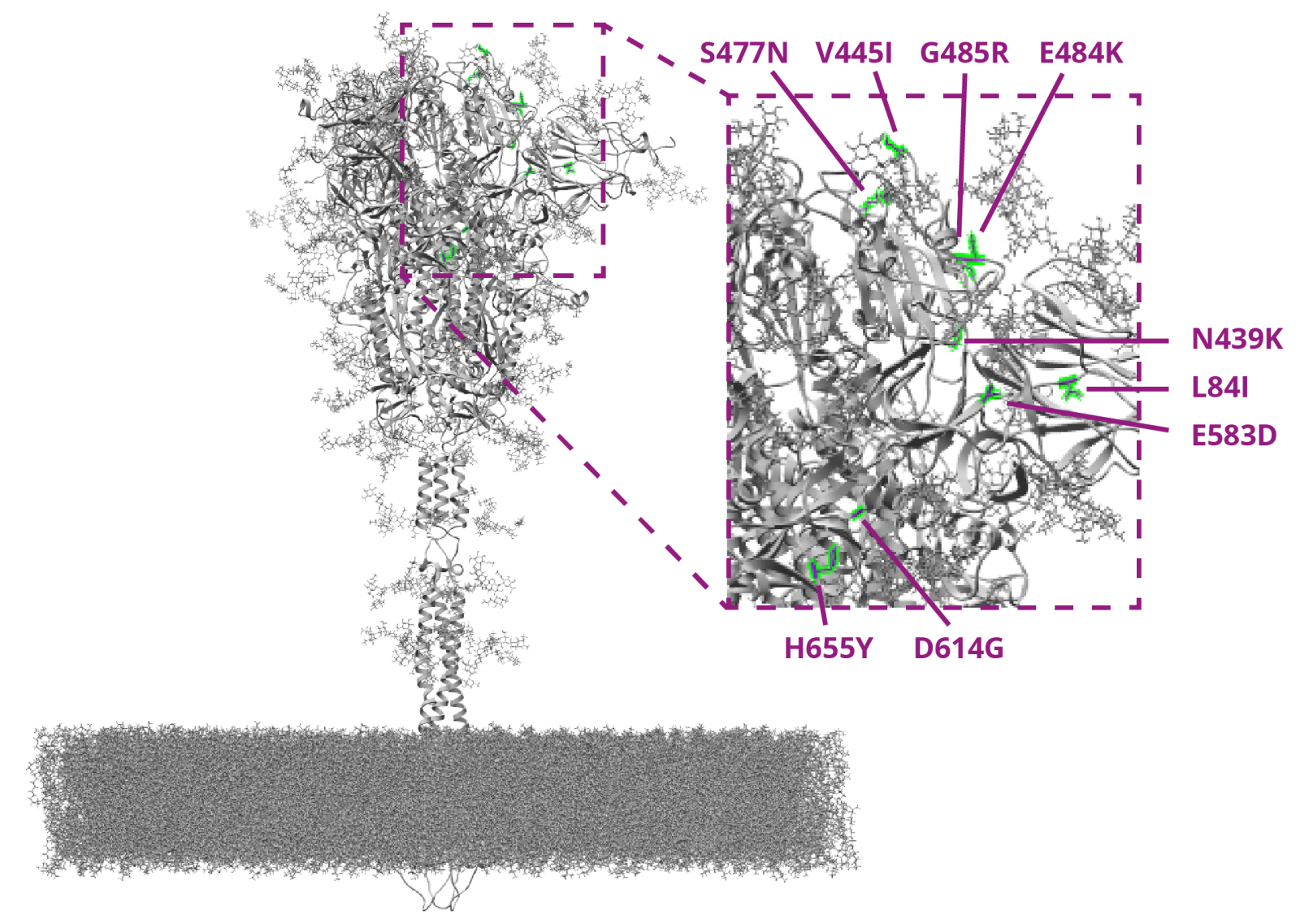 A subset of the mutations identified in the RBD domain of the spike protein occurs in more than one strain, although those variants are believed to be independently evolved. These convergent mutations, specifically, the N501Y (shared between B.1.1.7, B.1.351, P.1, and B.1.1.529) and E484K (shared between B.1.351, P.1, and B.1.1.529, i.a.), are of high interest because they may be the cause of the increased transmissibility (Zahradnik et al.). Furthermore, the K417N and E484K polymorphisms reduce sensitivity to neutralizing antibodies (Greaney et al.), which may indicate reduced efficacy of the immune response after infection and vaccination, respectively.
A subset of the mutations identified in the RBD domain of the spike protein occurs in more than one strain, although those variants are believed to be independently evolved. These convergent mutations, specifically, the N501Y (shared between B.1.1.7, B.1.351, P.1, and B.1.1.529) and E484K (shared between B.1.351, P.1, and B.1.1.529, i.a.), are of high interest because they may be the cause of the increased transmissibility (Zahradnik et al.). Furthermore, the K417N and E484K polymorphisms reduce sensitivity to neutralizing antibodies (Greaney et al.), which may indicate reduced efficacy of the immune response after infection and vaccination, respectively.
Fig: 3D structure of Spike trimer embedded in lipid bilayer.
Mutants are shown green and labelled accordingly. (Source: The Native Antigen)
To help you study and track the newly occuring variants of SARS-CoV-2, our suppliers make efforts to provide you with recombinant spike proteins of the newest known mutants the fastest possible.
Selected SARS-CoV-2 Mutant Recombinant Spike Proteins:
| SARS-CoV-2 Variant | Mutations | Art.-Nr. | Product Description |
|---|---|---|---|
|
European Variant B1 |
D614G | SCM-C19S1-G231H | Signalchem SARS-CoV-2 Spike Protein S1 (D614G) |
| SIN-40591-V08H3 |
Sino Biological SARS-CoV-2 S1 Spike Protein (D614G)-His, HPLC-verifiziert |
||
|
Alpha Variant B.1.1.7 |
del69-70, del144, N501Y, A570D, D614G, P681H,T716I, S982A, D1118H |
GTX136059-PRO |
GeneTex SARS-CoV-2 (COVID-19) Spike (del69-70,del144,N501Y,A570D,D614G,...) (ECD) Protein, His tag (active), Unconjugated |
| NAC-REC31924-100 | The Native Antigen SARS-CoV-2 (B.1.1.7) Stabilized Spike Glycoprotein, His-Strep-Tag (HEK293) | ||
| NAC-REC31946-100 | The Native Antigen SARS-CoV-2 (N501Y Mutant) Spike Glycoprotein (S1) RBD, His-Tag (HEK293) | ||
| SIN-40592-V08H82 | Sino Biological SARS-CoV-2 (2019-nCoV) Spike RBD(N501Y)-His Recombinant Protein | ||
|
Beta Variant B.1.351 (501Y.V2) |
L18F, D80A, D215G, del242-244, K417N, E484K, N501Y, D614G, A701V | GTX136022-PRO | GeneTex SARS-CoV-2 (COVID-19) Spike RBD (K417N, E484K, N501Y Mutant) protein, His tag (active), Unconjugated |
| GTX136095-PRO | GeneTex SARS-CoV-2 (COVID-19) Spike S1 (L18F, D80A,..., R246I, K417N, E484K, N501Y, D614G), His tag (active), Unconjugated | ||
| NAC-REC31963-100 | The Native Antigen SARS-CoV-2 (B.1.351) Stabilized Spike Glycoprotein (Trimeric), His-Strep-Tag (HEK293) | ||
| NAC-REC31926-100 | The Native Antigen SARS-CoV-2 (501.V2) Stabilized Spike Glycoprotein (Full-Length), His-Strep-Tag (HEK293 | ||
| NAC-REC31945-100 | The Native Antigen SARS-CoV-2 (501Y.V2: K417N, E484K, N501Y) Spike Glycoprotein (S1) RBD, His-Tag (HEK293) | ||
| BIV-P1645-50 | BioVision Human CellExp(TM) SARS-CoV-2 Spike RBD (K417N, E484K, N501Y) | ||
| ELA-PKSV030319 | Elabscience Recombinant SARS-CoV-2 Spike RBD (K417N,E484K,N501Y) (His Tag) | ||
| DBP-DPREC-021 | Daresbury Proteins SARS-CoV-2 trimeric soluble full-length Spike protein, Beta variant, S protein, HEK293 cells | ||
| ABX160085 | Abexxa SARS-CoV-2 S1 Protein RBD (Beta B.1.351 Variant), Unconjugated, Insect | ||
|
Gamma Variant B.1.1.28 P1 |
L18F, T20N, P26S, D138Y, R190S, K417T, E484K, N501Y, D614G, H655Y, T1027I, V1176F |
GTX136091-PRO | GeneTex SARS-CoV-2 (COVID-19) Spike (ECD) Protein, P.1 / Gamma variant, His tag (active), Unconjugated |
| GTX136043-PRO | GeneTex SARS-CoV-2 (COVID-19) Spike RBD Protein, P.1 / Gamma variant, His tag (active), Unconjugated | ||
| GTX136094-PRO | GeneTex SARS-CoV-2 (COVID-19) Spike S1 Protein, P.1 / Gamma variant, His tag (active), Unconjugated | ||
| NAC-REC31944-100 | The Native Antigen SARS-CoV-2 (B.1.1.28)Stabilized Spike Glycoprotein (Full-Length), His-Strep-Tag (HEK293) | ||
| NAC-REC31961-100 | The Native Antigen SARS-CoV-2 (B.1.1.28: K417T, E484K, N501Y) Spike Glycoprotein (S1) RBD, His-Tag (HEK293) | ||
|
Delta Variant B.1.617.2 |
L452R, T478K | GTX136332-PRO |
GeneTex SARS-CoV-2 (COVID-19) Spike RBD (L452R, T478K Mutant) protein, His tag, Unconjugated |
| NAC-REC31974-100 | The Native Antigen SARS-CoV-2 (B.1.617.2, L452R, T478K) Spike Glycoprotein (S1) RBD, His-Tag (HEK293) | ||
| SIN-40589-V08H10 | Sino Biological SARS-CoV-2 B.1.617.2 Spike S1+S2 trimer Protein (ECD, His tag) | ||
| DBP-DPREC-024 | Daresbury Proteins SARS-CoV-2 trimeric soluble full-length Spike protein, Delta variant, S protein, HEK293 cells | ||
| PRS-21-831 | ProSci SARS-CoV-2 (COVID-19) Delta Variant (B.1.617.2) Spike RBD (L452R, T478K) Recombinant Protein | ||
| ABX620012 | Abbexxa SARS-CoV-2 Spike Protein RBD (Delta B.1.617.2 Variant), Unconjugated, Mammalian cells | ||
|
Kappa Variant B.1.617.1 |
E484Q, L452R | NAC-REC31971-100 |
The Native Antigen SARS-CoV-2 (B.1.617.1: E484Q, L452R) Spike Glycoprotein (S1) RBD, His-Tag (HEK293) |
| GTX136299-PRO | GeneTex SARS-CoV-2 (COVID-19) Spike RBD (L452R, E484Q Mutant) protein, His tag (active), Unconjugated | ||
| SIN-40589-V08H11 | Sino Biological SARS-CoV-2 B.1.617.1 Spike S1+S2 trimer Protein (ECD, His tag) | ||
|
Omicron Variant B.1.1.529 |
A67V, H69del, V70del, T95I, G142D, V143del, Y144del, Y145del, N211del, L212I, ins214EPE, G339D, S371L, S373P, S375F, K417N, N440K, G446S, S477N, T478K, E484A, Q493R, G496S, Q498R, N501Y, Y505H, T547K, D614G, H655Y, N679K, P681H, N764K, D796Y, N856K, Q954 | GTX136716-PRO | SARS-CoV-2 (COVID-19) Spike RBD Protein, B.1.1.529 / Omicron variant, His tag, Unconjugated |
| SIN-40592-V08H121 | Sino Biological SARS-CoV-2 B.1.1.529 (Omicron) Spike RBD Protein (His Tag) | ||
| SIN-40591-V08H41 | Sino Biological SARS-CoV-2 B.1.1.529 (Omicron) Spike S1 Protein (His Tag) | ||
| SIN-40589-V08H26 | Sino Biological SARS-CoV-2 B.1.1.529 (Omicron) S1+S2 trimer Protein ( ECD, His Tag) | ||
| SCM-C19S1-G231OH | Signalchem 2019-nCoV Spike protein S1 (Omicron) | ||
| SCM-C19SD-G231OH | SignalChem 2019-nCoV Spike protein RBD (Omicron) | ||
| MCE-HY-P74443 | MedchemExpress SARS-CoV-2 Nucleocapsid Protein (Omicron, B.1.1.529, His) | ||
| MCE-HY-P74444 | MedchemExpress SARS-CoV-2 S Protein (Omicron, B.1.1.529, His) | ||
| MCE-HY-P74445 | MedchemExpress SARS-CoV-2 S1 Protein (Omicron, B.1.1.529, His) | ||
| MCE-HY-P74447 | MedchemExpress SARS-CoV-2 S Protein RBD (Omicron, B.1.1.529, His) | ||
|
B1.1.298 |
Y453F | SIN-40592-V08H80 | Sino Biological SARS-CoV-2 Spike RBD(Y453F)-His rekombinantes Protein |
|
B.1.141 / B1.258 |
N439K | SIN-40592-V08H14 | Sino Biological SARS-CoV-2 (2019-nCoV) Spike RBD(N439K)-His rekombinantes Protein |
From System Biosciences, Lentivector Packaging Mixes are available, pseudotyped with the SARS-CoV-2 S1 spike protein in several variants, including the beta variant B.1.351 (K417N, E484K, N501Y, and D614G).
Further SARS-CoV-2 mutant spike proteins are in development at several of our suppliers and will soon be available. If you are looking for a specific mutation, which is not yet available in our web store, please feel free to contact us and we will do our best to find the right protein for you.
26.01.2022
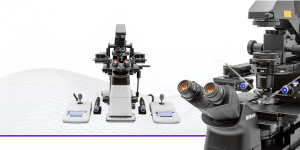
Cell Manipulation
MDR Approval for Medical Devices
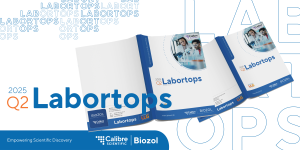
Labortops #2
Super Sale: up to 88% off labware
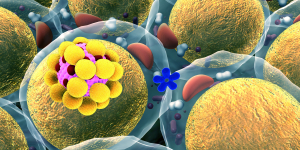
Obesity and Metaboli...
Research Reagents from Rockland, GeneTex and more

Spring Promo
Up to 30 % off Antibodies and ELISA kits
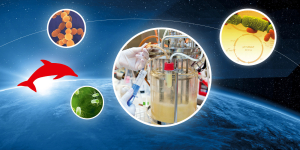
Protein Expression
MoBiTec Cloning and Expression Vectors

